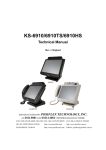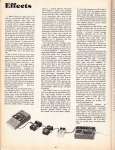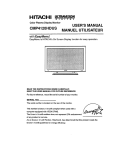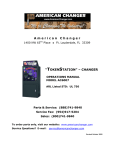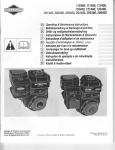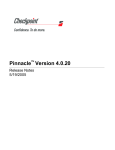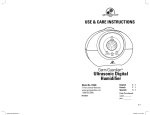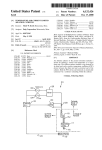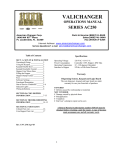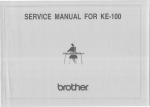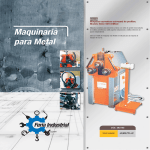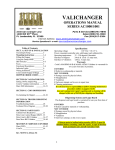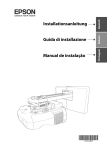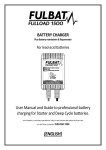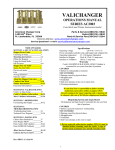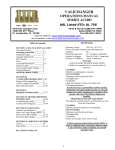Download VALICHANGER - Shaffer Distributing
Transcript
VALICHANGER OPERATIONSMANUAL SERIESAC6000/6001/6002 American Changer Corp. 4710 NW 15’h Ave. Bldg. 5 Ft. Lauderdale, FL 33309 Parts & Service:(888)741-9840 Sales:(800)741-9840 Fax:(954)772-5248 Internet Address:www.americanchanger.com SECTION A: SET-UP AND INSALLATION Uncrating & Setup .................... 3 Fill@ the Hoppers ................. 3 Using the Dump Mode .............. 3 DIP Switches. ........................ 3 & 6 Hopper Pay out Table ............. 4 Bonus Pay Out Table. .................5 Fuses ................................... 6 About the hopper/Coin sizes ......... .6 Indicator Lights.. ..................... 6 NEW HOPPER ERROR CODES . ..7 Functional Descriptions. ............ 7-8 Wiri”g defmitions.. ................. 8 SECTION B: VALIDATOR INFORMATION .,8-l 1 ’ CoinCo Validator information ........ . Cleaning the coi”c0 ................. .9 Setting the CoinCo dip switches...1 0 Clearing a bill jam in the CoinCo.11 SECTION C: COIN HOPPERS INFORMATION.. ................... .12-18 SECTION D: TROUBLESHOOTING INFORMATION. .....................19-21 Troubleshooting Guide ................19 Technical Flow Diagram ..............20- 2 1 SECTION E: PARTS LISTS Cabinet Parts Breakdown., .......... ..2 2 Parts Coin Control Hopper MKIV .. .23 Parts CoinCo Bill Validator ........ ..24-2 7 CoinCo 6mncheS and Service centers are on the back cover of this manual. Rev. TRPL”RC” Nov.98 Specifications Operati”g voltage 120VAC+lO/-15 % Power consumpt.(controller only, add hoppers and validator) 1 Ow Operating temperature 32 130 degrees Fahrenheit Interface to Hoppers 24vdc & 12vdc 1.5 amps nux. Interface to Validators 120vac .5 amps max. Warranty CoinCo BA30B - BA30BB Validator The Coin’& BA30B BA30BB Dollar Bill Validator is warranted for two years from date of purchase. COVERED Ji Defect in workmanship or material. NOT COVERED f Damage caused by physical abuse. Y Misapplication. Y Vandalism. H End “sers attempt, on his own to repair iteni $ Clea”i”g maintenance. It is the End User’s responsibility to follow cleaning maintenance procedure outline on page B-2. Any unit coming in for repair requiring only a cleaning will be charged a flat rate of $35.00 plus shipping and handling. i Dispensing System and Logic Board The dispenser and logic boards are warranted for one year fro& date of purchase, COVERED v Defects caused by material “I wor’ananship. NOT COVERED Y Damage caused by physical abuse. Y Misapplication. f Vandalism. Y End Users attempt, on his own to repair. A Return material authorization number (RMA#) must be obtained before returning a unit for repair. A copy of invoices must accompany any and all warrantee work. UNCRATING AND SET-UP Remave your Series AC6000-6002 changer from the shipping box. Open the door. (The T-handles are e screw-in &pe and therefir, musk be fumed at leas! IO times counterclockwise unlil il opens.) Inspect for any ConneCtOTs Or components that may have been dislodged during shipping. The lock and keys for your changer will be inside the manila envelope along with this manual. To install the lock, insert the cylinder into the round hole in the middle of the T-handle and push until it stops. Now turn the key and lock until you hear it “snap.” Turn the key counter-clockwise % turn and remove the keys. The only way to get a duplicate set of keys made is to save the red tag that comes between the ,keys. This ID # starts with ACC KOTE: FILLING THE HOPPERS When each hoppers has less than 80 . 100 coins left the red “Empty” LED will light on the front of the changer. If you have disconnected your LED make sure the orange wire is going to the terminal on the LED that has the red positive mark next to it. \hhcnever the “Empty” LED is “ON” the validator is disabled and it will no longer accept bills. 1. Turn OFF the power on the main logic board. 2. Pour the coins into the large opening in the funnel on the top. There mat be nf leas1 enough coinr fo cover t h e two g o l d ploter of the bottom of the hoppers. (Somewhere between 160 and 17,000 coins minimum to maximum.) 3. Turn “ON” the power switch. The “Empty” LED is now off and the bill validator is ready to accept bills. 1. TEST: Before permanently installing the changer, do a functional test to verify that there is no shipping damage to your new changer(s). 2. 3. 4. Extend the power cord through the hole in the back of the changer or the bottom and plug it into a grounded IZOwc outler. The dip switches are already set for a 4 coin per dollar pay-out of the hoppers, and the Bill validator is ready to accept $I-$5-$10.SZO dollar bills. 5. Fill tbe each hopper with at least 100 coins. On the main logic board rum the switch on the bonom right comer “ON”. (SEE FIG. 1 ON PG.3) The rocker switch has a “I ” and “0” printed on it. When the “I ” is pressed down the changer is “ON”. __.__._^_.___..._ - BILL METER ‘I USING THE DUMP MODE TO EMPTY THE HOPPERS Open the cabinet door. Turn OFF the POWER switch. Place a suitable container in front of the hoppers to catch the coins. Press and hold the “DUMP” button on the upper right comer of the Main Logic Board. Turn ON the Power switch. The red LED numbers on the main logic board will come on all “88888’s” then go all “00000’s”. Once the red “00000’s” light up, release the “DUMP” button. If it is not released within wo seconds, the “DUMP” mode is canceled as a security feature. The hoppers will dispense coins until the POWER switch is turned OFF. If the red LED numbers are not counting up rapidly on the Main Logic Board‘s display the dump mode was not accessed. Please try again. THE DIP SWITCHES The AC6000-6002 series changer is capable of dispensing coins in different pay opt modes. Sating the coins out per dollar is controlled by which Dipswitches turned “ON.” (Refer to figure I for their location.) For example. switch #2 is “ON” on both dipswitches; therefor the payout equals 4 coins per dollar. Two coins per hopper for one dollar. ._-.- ‘T THE DIPSWITCH BANK FOR SETTING ~THE BILL DENOMINATIONS. (For those dip switches go to page IO.) IFUSE 1 l&D INPUT I DIPSWITCH OPTION SETTINGS 4 Tokens with a bonus payback in $1 incr. (See bonus table. I 1 Set in $1 increments I ISee bonus table. I lo lo lo lo lo lo lo lo ISee bonus table. I (See bonus table. I BONUS PAY-OUT TABLE ALL CALCULATIONS ARE BASED ON THE TOTAL COINS YOU SET FOR THE $1.00 BILL For Mode #8, dirregard the % sign. (I.e. %2 = 2 tokens not $2 ilr tokens.) THE FOLLO\h’fNG BONUS OPTIONS ARE CONTROLLED BY THE RIGHT DIP SWITCH ONLY!! “NO” MEANS “NO BONUS” FOR THIS BILL. Another way to look ut the Bonuspay out mode is as follows: The bonus is paid out by the amount of tokens given for a dollar. For fhe below explanation we will say you are giving 4 tokens per dollar. Left dips #3-#6-#7 is ON. Right dipswitch For a S5.00 bonus payout: #I 112 OFF OFF 20 tokens + no bonus 20 tokens + 4 extra tokens ON OFF 20 tokens + 8 extra tokens OFF ON 20 tokens + I2 extra tokens ON ON For the $10.00 bonus pay first double the pay out for the S5 bill. So if the total tokens given for the 55 bill was 24, the pay cut for the SIO bill is 48 tokens. t&v let’s figure out the bonus for the SIO bill. Right dipswitch #3 #4 OFF OFF ON OFF OFF ON ON ON Right dipswitcb For a 520.00 bonus payout: #S #6 #7 OFF OFF O F F SlOpayout+nobanus ON OFF OFF 510 pay out + 4 extra tokens O F F OK OFF 510 pay out + 8 extra tokens OFF SIO pay out + I2 extra tokens ON ON OFF ON 510 pay out i I6 extratokens ON S IO pay out + 20 extra tokens OFF ON ON ON ON ON S IO pay OUI + 24 extra tokens For a $10.00 bonus payout: SSpayout+nobonus 55 pay out + 4 extra tokens SS pay out + 6 extra tokens 55 pay out + 12 extra tokens The following table shows how to set the dip switches to your desired payout. “Oh”’ COINS PER DOLLAR #I 1 #2 2 $3 4 #4 8 If you want to dispense 5 dimes and 2 quarters per dollar turn “Oh”’ switches #2 on the left and #land #3 on the right dip switch. (2 quarters + 5 dimes = $1 .OO) Indicator Lights Main Logic Bonrd.~ 1. Green LED on: AC power applied to the logic board. All fuses are good. 2. Decimal Point: A. H&bear 5 and 12vdc present. The changer is in standby waiting for a bill pulse. B. On Steady Out of service, Hopper error detected. Validam /ogic board: 1 . RcdLED A. On Steady Standby h4ode, waiting for bill l”XTt!O”. B. Flashing - Error mode, go to page for error code informarion. C. Off - The changer “Empty” LED is lit. The kft dipswitch controls the left hopper’spay out and the right dipswitch controls the right hopper's pay auf Refer to the next table to set up your changer for the settings you need. FUSES Hieh voltaee fuse: This ir the primary transformer AC fuse for the main logic board and the validator. Any direct shoti of the Transformer or validator will cause this fuse to blow. Replace this fuse with a 2-N amp AS fuse only. REPLACING THIS FUSE WITH ANYTHING OTHER THAN A 2 % AMP ‘AS” MAY RESULT IN A FlRE OR AN UNSAFE WORKING CONDITION!! (See fig. 1 for 1 Coin counting 1 LED. Hopper coin bin. (Dump the coins into this hole. 1600 coins location of this fuse.) Security LED. Low voltaee fuse: This is the secondary transformer fuse for (all systems OK) the 5 28 vdc sections of the main logic board and hoppers. It is located to the left of the transformer. (See tig. 1) Replace this fuse with a 2-s amp AS fuse only. L2vdc Power LED.1 REPLACING THIS FUSE WITH ANYTHING OTHER THAN A 2 % AMP “RS” MA Y RESLJL T IN A FIRE OR AN UNSAFE WORKING CONDITION!! Coin Control Hopper MKIV Three green LED indicators are fitted on the hoppers and are visible in the section where the coins exit the hoppers. From left to right these are designated as follows: 1. Logic power supply on (12 & 24vdc present). 2. Security optical obstruction indicator -. Should be “on” when unit is OK. 3. Output indicator, indicates coin passing photo-sensor. This is the optical sensor the coin will obstruct on its way out of the hoppers. For normal operation LED # 3 will be off until coins are dispensed. coin counting optic. 1 l-l 12 pin male connector. (located on the 1 bpposite side.) j - I CoimToken Sizes The hoppers will automatically adjust to dispense coins/tokens in size from 20-30 mm in diameter and I .25 3.5 mm in thickness. The right & lefi homer has a removable coin chute installed. There is an option available to dispense smaller coins. A nickel is approximately 21 mm a quarter is approximately 25mm A Susan B. Anthony is 28mm 6 I I I I LOGIC BOARD ERROR CODES 6. The EPROM then sends the hopper pulses out pin #23 to pins 6 and 7 of the red 12 pin hopper plugs. These pulses travel through the purple and brown wires of the hoppers wire harness to the hoppers pins 8 and 12. 1. The hopper turns itself on with the first hopper pulse. The hoppers counts the hoppers pulses sent from the EPROM chip on fN3 (pin 12) while dispensing the coins at the same time. when the amount of hoppers pulses in equals the coins dispensed through the coin counting optical sensor the hopper turns itself off. 8. The Changer returns to the standby mode with the decimal point flashing once per second until another bill is inserted. We now have the ability to display error codes in dealing with the problems associated with the changer. There are 2 different locations error codes can be displayed depending on the source of the problem. If the “Empty” LED on the outside of the changer is lit: I. Press and hold in the “Dump” button on the main logic board. 2. The display now shows the code for your problem. NOTE: THE METER ON THE MAIK LOGIC BOARD CANNOT BE RESET TO ZERO!!! Functional Descriptions of Out-of-Service Conditions Error Codes 01 = Low Coin 02 = Coin exit window is blocked 04 = Under-payment was detected 10 = Over-payment was detected and prevented. (Jackpot condition) 1. A “03 ” error code is a low coin and eril blocked in the *ame hopper. Functional Description of the Series AC6000-6002 Changer the hoppers with coins and turn the changer on. 2. I. 2. 3. 4. 5. When power is applied the validator will cycle twice, the out-of-service LED flashes then goes out, the green LED on the main logic board comes on steady, and the decimal point on the main logic board number display will flicker on once per second in the standby mode. During the power-up mode the main logic board relay clicks twice enabling power (IZOvac) to the validator. When this relay is not enabled it routes 12vdc ground to the out-of-service LED. Without power to the validator the changer cannot accept hills. Since we are not in the error mode, the red LED on the validator logic board is on steady. When a bill is inserted into the validator bill slot, the bill will be pulled inside. The validator then compares what the bill looks like to its memory. After the hill is validated it grounds the 5vdc lines causing a pulse along the yellow and blue validator harness wires to pins 5 and I5 of the main logic board. Each pulse stands for the amount of the denomination validated. (i.e. I pulse for % I, 5 pulses for $5). The 5vdc pulse then travels from pins 5 and I5 to the EPROM chip (ver. TRPL-L) pin #25. The EPROM sends a 12vdc pulse to the meter chip (US) out pins #21 8; 22 (one pulse per denomination validated ).The EPROM also multiplies the bill pulse by the DipSwitch settings (The EPROM reads the DipSwitch settings during the power up mode and stores them into memory.) 7 Blown Fuse: an AC power spike in line voltage or a had transformer on the main logic board can cause A blown fuse on the main logic board. If either fuse blows the indication is the green LED on the main logic hoard will not light. A . I&place the fuse. If the green LED DOW lights then there was a spike. B. If it does not and the fuse blows again the power transformer is shorted. To test the transformer use a voltmeter set for ohms and measure across the primary (400hms) and the secondary (I .Sohms). Hopper Fault: A hopper fault can either be a jammed hopper, a blocked coin counting optic or a bad hopper logic board. A. Indications for a jammed hopper are the changer accepts bills, the meter counts up, but nothing or not enough coins are paid out. 1. After 2 minutes the EPROM shuts off the validator if the coins are not paid out correctly. The “Empty” LED will flash once per second. 2. At this point the three options open are to attempt repair on your own, call your distributor, or return the defective hopper to American Changer. B. Indications for a blocked coin optic or bad hopper logic board arc the out-of-service LED on the outside of the changer is lit and the red LED on the main logic board is lit and flickers off once per second. 1. If two of the 3 green LED’s on hopper IO&Y hoard are lit then the hopper logic hoard is bad. 2. If there is a coin or foreign object caught in the coin exit window LED’s #I and #3 will he lit on the hopper logic board instead of LED’s #I and #2. a. Take off the side of the hopper with the 5 Philips screw?. Pull up on the Yellow - Raw sensor output line. Purple - Hopper pay out line from main logic board (+). B r o w Hopper pay out line from main logic board (-). Red +lZvdc logic board supply voltage. Black(s) -IZv, 24~ low coin sense ground. Orange i24vdc Motor supply voltage. exit window logic board and look for the jammed item. b. Ensure you have the pins aligned before reconnecting logic board. 3. Validator Fault: When a validator fault occurs the ralidator’s EPROM shuts down the valid&x and flashes an error code via the red LED on the validator logic board. When there is no error this LED is on steady. The vabdator only gives bill pulses to the main logic board so the main board never knows if the validator isn’t functioning. Therefore the out-of-serviceLED will not light. (See page 7 for validator error VALIDATOR INTERFACES 18 PIP INTERFACE CONNECTOR DETAILS CodeS.) 4. Low Coins: The low coin condition is probably the most common fault. The EPROM on the main logic board is constantly checking for low coins in the hoppers. This is done with a low current 5vdc signal on pin #3 of the hopper’s output connector. The voltage then travels down the hopper’s wire harness on the white wire to pin #7 of hopper’s plug. The signal is applied to one of the gold low contact plates at the bottom of the hoppers. The 5v travels through the coins through the other contact gold plate to hopper’s pin #2. It then goes through the black wire in the hopper’s harness to pin #IO on the main logic board. Any interruption of more than l/2 a second will cause an outof-service condition. A. Clean the bottom gold plates of the hoppers with steel wool or fine sandpaper. Refill the hoppers and try again. B. Check continuity, (0 ohms) resistance, from pins 3 (white) and IO (black) of the red hopper harnesses. Make sure both hoppers are full and the changer is turned off. 1. If the continuity is 0 ohms, replace the main logic board. C. Pull the hoppers out of the changer, then look at the 12 pin black male connector that sticks out of the hoppers. Place the continuity checker’s leads on pins 2 & 1. 1. If the continuity is 0 ohms, replace that hopper’s plate or adjust the hopper’s plate female socket’s pins so that they are not so spread out. 2. If the continuity is infinity, then replace that hopper. WIRE HARNESS COLOR AND DEFINITIONS Validam harness: Switched Hot IZOVAC. Red White - Neutral IZOVAC. Black - IZOVAC Low current validator enable. Y e l l o w +Svdc credit pulse line. Blue -5vdc credit pulse line. orange - +lZvdc Empty LED. B r o w n -12vdc Empty LED. Hopper Harness Coin counting optic status line. Gray White. Low coin sense (+5vdc). G r e e n Coin counting optic pay out feedback line. I IPin #IO Interfacing the Man 2501 Series with the ValiChanger S-Position Switch I off 2 3 4 5 6 0” off on off an off 1 green & white go to the other wire nut CoioCo BA30 Flash Codes Flash codes l-6 may appear during normal servicing of the BA30. To access flash codes 7.18, open bill box lid and remove power from the BA30 for IO seconds. Reapply power to BA30 with bill box lid open. Flash codes 7-18 will now appear for respective error or condition detected in the BA30. If more than one error or condition exists, the lower number flash code will appear until its respective error or condition is canected. The left and right sensors referenced below are given viewing the BA30 from the front. #of Flashes Description of Flash Codes Bill box full I Bill box lid is own or bill box is off 2 Check bill path’ 3 All bill accept switches are off 4 Bill jam or sensor error 5 Stacker motoribome sensor 6 nansport motor/encoder sensor 7 For higher error codes or any other service problems call our service deportmenl roilfree at: (888)741-8940 8 BA30B (B) CLEANING IF ANY OF THESE PROCEEDURES ARE PERFORMED TO YOUR VALIDATOR AFTER IT IS RETURNED UNDER A WARRANTY REPLACEMENT, YOU WILL BE SUBJECTED TO A S35.00 LABOR FEE. BA30B CLEANING AND hlAINTENANCE: tiote: Perroleunr-hued c/ennerr andjreon-basedpropeNnnlr can damage plastic and some elecrronic componentx. Scouring pads and srl/i brushes may harm the protective cor>formol coating on the circuit boards and can mar the phsric. These items should never be used when cleaning the BA30 bill acceptor. The BA30 should be cleaned every 7,000 bills or every 4 6 months (or BE needed, depending 00 the environmental auditions of the location). Dust can be removed with B soft brush or cloth or it can be blown out using compressed air. Procedure: I. Disconnect power from the bill acceptor. 2. Remove the bill box and use a soft cloth to wipe the dust from around the intermediate frame and stacker plate. 3. Remove the lower track. 4. Using compressed air or a soft brush, blow or brush the dust off of the optic sensors and out of the recessed sensor Ope”,“gs. 5. Remove dust from around the belts and wheels on the lower housing and the sensors on the upper sensor board. The upper sensors are located directly above the lower housing sensor when the lower housing is installed. 6. The bill path can be cleaned to remwe further din and oil usinc a soft cloth moistened with a mild soap and water I I thoroughly b&e op.&@ power to avoid possible shock hnrnrd. I/the srackerplate does not return to the home position, remove power and carefdly remow the bill box to ovoid damaging /he bill box and/or stacker plate. 4. Remove the lower housing. 5. Remove the bottom cover from the lower housing. 6. Run hot water (1101/4-140114F) over the lower housing from the top and bottom. Using a soft brush, gently clean any residual salt. Use a soft absorbent cloth to clean a n y residue off the lower housing. If the transformer gets wet, allow the unit to dry for 24 hours before applying power. I. Remove the front mask. Using hot water and a soft brush, clean the front mask, upper sensor board, main frame anti-pullback levers and position sensor mount. Caution, The motors ore not protected/ram water, therefore the unit must be held in n manner that prevents walerfrom running over the intormediotefiame crossbar. 8. Remove rhe position sensor cover on the crossbar and co@dly lift the LED&m its mount. (Early models only.) Caution: Protective coating on the LED leads should nor be dunaged. C/can all snl? residue from the mount. sensor hole and detector area. The detector con be seen through the sensor hole, and is iocared in the chassis. Replace the position sensor cover. (Early mod& only.) 9. Verify that the anti-pullback levers move freely and that the spring returns them to their open position. IO. Allow the unit to dry thoroughly. 11. Clean the magnetic head using a swab and isopropyl alcohol. I?. Replace the front mask 13. Replace the lower housing cover. 14. Replace the lower housing into the main frame. 15. Remount the bill box. 16. Apply power and insert bills to verify that the unit is functioning properly. 6 OR 7 ERROR CODE FLASHES The cleaningprocedurefor this common occurrence is listed below Just follow these s,qx. 1. If this &de has occur&d on a new machine or one that the validator’s DIP switches were just changed, Ensure that all the white plugs on the side of the validator board away from the red LED are plugged in securely. 2. Remove the bill box. 3. Turn the changer ON then OFF in an attempt to stop the metal push plate so that it COASTS into the fully outward position. 4. Using an air compressor or a can of compressed air blow out the area behind the push plate until if IS completely free of all dust and lint. 5. Turn the changer power back on so that the push plate returns to the inward position. If the same error code persists. repeat steps I - 3 concentrating on the top center area behind the plate. 6. Replace fhc bill box. d”b0”. 7. Clean the magnetic head using a swab and isopropyl alcohol. 8. Once the lower housing is dry, place if back into the mainframe so that the tab on the bottom locks into place. 9. Blow the dust out of the encoder wheel and its &XL. (It may be necessary to extend the stacker plate to access the encoder wheel. Supplying power to the unit momentarily can do this, so that the stacker plate extends.) 10. Remove dust from the transport belt areas and from any other places of build up. I I. Remount the bill box. 12. Apply power and insert bills to verify that the unit is functioning property. BA30 CLEANING PROCEDURE FOR SALT WATER POLLUTED UNITS: Note: Petroleum-based cleaners andfreon-basedpropellants con dnmoge plastic and some electronic components. Scouring pads and stiff brushes may harm the protective ro&mol coa,iog on the circuil boards and can mar the plastic. These items should never be wed when cleaning the BA30 bill occeplor. Procedure: 1. Remove power from the bill acceptor. 2. Remove the bill acceptor from the vending machine. 3. Open the bill box lid and verify that the stacker plate is in the stand-by/home position. If it is not in the home position, apply power and observe that the stacker plate returns home. 9 HOW TO SET-UP THE BILL VALIDATOR FOR ACCEPTING SPECIFIC BILL DENOMINATIONS. (I.E. $l.OO-$5.00~$lO.OO-$20.00 DIP SWITCH LOCATIONS) YOU MUST REMOVE THE BILL BOX IN ORDER TO STICK A SHARP THIN OBJECT INTO THE SLOT TO CHANGE THE DPSWITCH SE’M’lNGS. B 0 T T 0 M BA30BIBBIBAB Option Switch Settings SWITCH I 2 3 4 5 6 7 8 ON High Security Accepts bilk in one directions only (face up, green seal first) Standard credit pulse 150mson 150msoff $20 Accept $10 Accept 165 Accept $2 Accept $1 Accept OFF Standard Acceptance Accepts bills in both directions (face up) Short credit pulse 50 Ins on 50 Ins off $20 Reject $10 Reject S5 Reject $2 Reject (61 Reject 10 CLEARING A BILL JAM I”5” ERROR CODE FLASHS ON THE BILL VALIDATOR STATUS LED.) I EXPLOI)JW VU w I ---w P MKIV UNIVERSAL HOPPER INDEX PAGE SERVICE MANUAL 1. Coin box removal & reassemble. 12-13 2. Exit window replacement. 13 3. Logic board replacement. 14 4. End plate removal. 14 5. Track plate removal. 14 5a. Track plate assembly. 15 5b. Track plate replacement. I6 5c. Final drive gear replacement. 17 6. Gearbox assembly. 17 7. Motor replacement. 17 To w-jam the hopper, refer to sections 4 - 5b, pages 14 -16. 7. 1. COIN BOX REMOVAL 1, Place the hopper in front of you as shown, (looking at the outside of the ‘coin box’). As the ‘coin box’ is being removed, carefully slide the ‘logic board’ out. The stirrer may stay with the ‘coin box’ or fall onto the center plate. Refer to FIG 1, 2. Remove the 2 locking nuts, which hold the ‘low level sense plate’ wires to the studs. 3. Remove the crimp & wire from the studs. c WI, LOCKING NUI f STUD ACCESS IS NOW AVAILABLE TO THE ‘LOW LEVEL’ SENSE PLATES, THE MAIN PCB, THE EXIT WINDOW, THE MOTOR TERMINALS & PART OF THE WIRING LOOM. Refer to FIG la, 4. la. COIN BOX ASSEMBLY Remove the 5 screws indicated (B), which hold the ‘coin box’ to the ‘center plate’. Refer to FIG Ib. 6. Gently lift the ‘coin box’ away from the rest of the hopper. NOTE:- The ‘logic board’ & ‘stirrer’ are located in the ‘coin box’. 13 1. Firstly, locate the ‘stirrer in the ‘coin box as shown in FIG 12. COIN BOX ASSEMBLY (cont.) 2. Line up the ‘centre plate’ Kr ‘coin box’ as shown below. FIG 12a. 3. Route the ribbon cable as shown below. 4. Fit the ‘logic board’ into slots shown below. 5. Feed the level sense wires through the slot shown below. FIG 12c FIG 12a Ribbon 7. Align the ‘center plate’ & ‘coin box’ & push together. 8. Turn the hopper OWI & refit the screws. 9. Refit the level sense wires slot 2. EXIT WINDOW REPLACEMENT 1. First, remwe the ‘coin box’, section 1. This will then enable access to the ‘exit window’ 2. Unscrew & remcwe the 2 fntig screws. FIG 4. 3. Remove the ‘exit window’ from tix ‘center plate’. 4. Unclip & remove the lo-way ribbon cable header. 6. Lift the ‘cent~e plate’ to meet the ‘coin box’. FIG 12b &c. 5. 14 To re-assemble, follow the above steps in reverse. F’G6’ 7 3. LOGIC BOARD REPLACEMENT 1. rl First, remove the ‘coin box’, section 1. This will then enable nccm to the ‘logic board’. 9ofl / COIN EXIT FIG 5. s,onwng plofe pas 2 [ADMCENT) 5. NN 2 LOGIC BOARD lo-way ribbon IDC socket (CONN 1). 2. 3. 4. 5. 6. I. 8. Move the two ejector arms at right angles to & away from the connector, if fitted. This should release the socket from the header. Clasping the connector between thumb & forefmger, pull away from pin header. 14.way crimp socket (CONN 2). Gently, unclip the “friction lock” from the connector housing. Clasping the connector between thumb & forefmger, pull away from pin header. The Logic Board is now released. To reassemble, follow the above steps in reverse. 4. END PLATE REMOVAL 1. Place the hopper in front of you as shown, (looking at the outside of the ‘end plate’). Refer to FIG 6. 2. Remove the 9 screws indicated (B), which hold the ‘end plate’ to the ‘center plate’. 3. Locate the position of the ‘connector blanking piece’. 4. Holding the ‘connector blanking plate’ gently lift the ‘end plate’ away from the rest of the hopper. 15 s\onring plate pa I lOPPOSlIE) l To re-assemble, follow the above steps in reverse. 5. TRACK PLATE REMOVAL 1. 1. First, remwe the ‘end plate’, section 6. See FIG 7. 2 . The ‘elevator track’ & ‘foal drive gear’ can now be removed by lifting up & away from the ‘center plate’. Final drive ,,.,_ gear (Plasti:::: 5a. TRACK PLATE ASSEMBLY The following 3 sketches show how to take the ‘track plate’ apart The fdowing 3 sketches show how to assemble the ‘back plate’. 16 5b. TRACK PLATE REPLACEMENT 1. The gray shaded area, in FIG 7b, is the ‘track plate’ guide path, FIG 7b. to centre plate 2. Once the ‘hack plate’ is in position, lam the track through 720 ’ to enswe it is seated in the guide path correctly 5. FINAL DRIVE GEAR REPLACEMENT 1. Once the ‘elevator track’ is in place, the ‘foal drive gear’ can be fitted by placing the gear wer its mounting spindle, while lining the teeth up with the secondary drive gear, adjust the ‘elevator track’ so that the gear falls into place. FIG 7~. 2. The end plate can ILOW be re-fitted. See section 6 FIG 7c. Final drive gear (PlOstiCI 17 6. GEAR BOX ASSEMBLY 1. Remove the end plate. Section 6. 2. Remove the ‘elevator track’ & ‘fmal drive gear’. Section 7. 3. Remove the gearbox cover. Section 8. 4. Remove the gears in the order as shown in FIG 9. access to the motor fixing screws is now possible. 5. To re-assemble, follow the above steps in reverse. FIG 9. FIG 7. MOTOR REPLACEMENT 1. Remove the ‘coin box’. Section 1. 2. Unsolder the red & black wires from the motor. NOTE: The black wire connects to the terminal marked with a RED dot. 3. Remove the ‘end plate’. Section 6. 4. Remove tbe ‘track plate’ & fmal drive gear. Section 7. 5. Remove the gearbox cover. Section 8. 6. Disassemble the gearbox. Section 9. 7. Unscrew the 2 motor fixing screws. FIG 10. 8 . To re-assemble, follow the above steps in ~e”erse 18 NOTE: Before starting this procedure ensure the changer is plugged in, the ON/OFF switch is on, the hoppers orefull of coins, and aI wire harnesses we connected securely and correctly. Thr wires exiting the red connectors shouldpoint awayfrom the board.‘! Start here !!! Is the “Empty” LED o” the front of the machine lit? \rrf -. on the main logic board? YES and clean the Will the valid&or accept a bill and stack it in the bill box? , IY” Wilt the validator try to 1 pull in a bill then reject it? NO YES Does the meter on the Main Logic 1 Board count ;p? 1 . If fuse blows again replace the Main Logic board. 1. 2. NO Replace the bill validator. Replace the bill validator wire harness. (Check the yellow&blue wires) I + The validator logic board is flashing an error code. Refer to pg. 9 for code definitions. “wq YES , . _I weiving the bill pulses but the hoppers are not receiving the pay out pulses. E n s u r e t h e h o p p e r s ar’ plugged in fdy in the bacl to the hoppers plate. One of tbe hoppers i jammed. Refer to pgs.22-2: to repair the hoppers. hames~ The hopper’s connector is faulty. Replace the hopper. Replace the hopper’s harness. I The main loeic board is readine a hoppers hard fault or a “Nohoppers found” fault. 1. Ensure the hoppers are plugged in firmly in the back to the hopper’! plate. 2. Ensure that the left and center green LED’s on the hoppers are lit. 3. If the left and right green LED’s are lit then something is jammed in the hopper’s exit window. See page to clear the jammed object. 4. Replace tbe hopper. 5. Replace the hopper’s harness. 6. Replace the main logic board. .-.., a low e& indication. Make sure the hoppers are plugged securely into its connector. Clean the gold low contact plates located under the coin with steel wool or a fine grit sandpaper. Make sure the female connector on the hopper’s plate is not broken OT being pushed out the back of the hopper’s plate. Go to the next page and follow procedure “BY ‘or a more detailed trouble shooting information proceed to the next section! FOR TECHNICAL SERVICE OR TO OBTAIN A RETURN AUTHORIZATION N U M B E R C A L L (888)741-9840 A N Y R E P A I R R E T U R N E D WlTHOUT A RETURN AUTH. # WILL BE REFUSED! 19 -! Solution: 5. 6. 7. 6. Ensure the changer is plugged in. Ensure the on/off switch is rocked to the (I) position !down). Unplug the female end of the line cord from the main logic board AC connector and plug it in again tightly. Measure the AC voltage at the outlet or check the breaker/fuse box. You can also plug another item into the AC wall outlet to fnsure there is power prescnr at the outlet. Inspect the AC line cord for cuts OT abrasions. Check both fuses on the Main Logic Board. Replace the main logic board. Replace the line cord. I. Ensure the hoppers are not out of coins. (There should be enough I. A. The changer is completely dead. (The green LED on the main logic board is not lit.) B. The “Empty LED is lit. The decimal point on the light-up number display is “off’ more than it is “011”. 2. 3. 4. 2. 3. 4. coins in the hoppers to cover the gold low level contact plates approximately S30-$40. These plates are located at the bottom of the hoppers where you Pour the coins.) Check the hoppers wire hamess that extends from the back of the plate that the hoppers slide in and out on for chipped pieces or other damage. (Pay close attention to pinr# 2 & 7.) Clean the gold contact plates with steel wool. Perform the following steps: Turn the change; off. A Ensure the left hopper plate red connector on the left side of the B main logic board (MLB) is plugged into the bottom connector, and the right is plugged into the top connector. C On the MLB slide all the dipswitches left to the “off’ position. D On the left DipSwitch slide #3 “ON” enabling a 4 coin per dollar plyOUt. On the right Dip switch slide #8 “ON” disabling the top hopper connector and enabline the changer into the”One Hostler 1. Mode” F. Turn the changer on. _ G If the “Empty” LED on the front of the changer is now off, remove the right hopper and service this hopper. The changer will function in this mode until the hopper is fixed. H If the “Empty” LED is still “on”, turn the changer off and switch the hoppers, and turn the changer back on. If the “Empty” LED on the front of the changer is now off, I. remove the right hopper and service this hopper. The changer will function in this mode until the hopper is fixed. Remember IO remove the coin chutefrom the hopper or ihe coins will/a/l into the changer instead of into the coin cup! If the “Empty” LED is still “ON”, turn off the changer. 1. K. Reverse the hopper’s plate connections, (top to bottom, bottom to top), and repeat steps F thru I. Keep in mind that you are trouble shooting the Hopper Plates instead of the hoppers Replace the Main Logic Board. Replace both hoppers. Replace both hopper plates with the harnesses E, 5. 6. 7. C. The “Empty LED is lit. The decimal point on the light-up number display is “on” more than it is “Off’. I. 2. Ensure the hoppers arc pushed into the hopper’s harness on the back of hopper plate tightly. Ensure that left and center green hoppers LED’s are Iit only. Not the left and right LED’s. If this is the case go to pg. 20 to w-jam the hopper exit window. 20 PROBLEM: D. The green LED on the Main Logic Board is lit but the Light-up display does not. E. The bill validator accepts and stacks the bills, but the meter does not increase. F. The bill validator accepts and stacks the bills, and the meter does increase. G. The bill validator will not pull in the bill and the “Empty” LED is not lit. SOLUTION: 1. 2. Bad 5 or 12vdc regulator on the main logic board. The hoppers are shorted. 3. 4. Replace main logic board. Replace hoppers. 1. Cheek continuity and for pin damage to the blue and yellow wires on the validator harness. Replace the valid&r wire harness. Replace the validaror. 2. 3. 1. 2. 3. 4. 1, 2. 3. 4. 5. H. The bill validator pulls in the bill slightly then rejects it. I. The bill validator red status LED flashes a “5” error code. 1. 2. 3. 1. 2. 3. Ensure the orange wire going to the “Empty” LED is connected to the + OT the terminal with the red mark by it. Check for 12vdc going to the orange and brown wires. Ifthere is, replace the LED. Replace the main logic board. Replace the bill validator. Reolace the valid&x wire harness. Clean the validator. (p&IO) Remove the lower housing (pg. 12) of the bill validator. Ensure the center wheel spins freely. Push snaight down on it slightly to loosen. Replace the bill validator. Clean the validator optic LED’s (See pg.10) Ensure that all the wire harness plugs are plugged firmly into their white female sockets. Turn to the back page of this manual and check for a Coin Acceptors branch in your area to repair your bill valid&or Take the bill stacker off the bill validator. Cycle the power on 1 off using the switch on the main logic board and coast the silver push bar so that it stops in its fully extended position. Blow out the area behind the push bar with high pressure or canned air. Concentrate on the encoder wheel in the area top center behind the push bar. Turn to the back page of this manual and check for a Coin Acceptors branch in your area to repair your bill validator J. The bill validator red status LED flashes a “6 or 7” error code. K. The bill validators red status LED is on steady but it still will not accept the bill. Ensure the dip switch settings are still correct. (#3 “ON” only) Check the continuity of the brown and purple wires on the hoppers wire harness. The hopper is jammed. Go to pgs.22-25 to u-jam the hoppers. Replace the hoppers wire harness. I. 2. Pull our the lower housing, see page 12, and look for something obstructing the bill path. (i.e. gum, papers. tickets, coins, etc.) Look inside the Plexiglas case on the side of the bill validator. Ensure that all the wire hamess plugs are plugged firmly into their white female sockets. 21 PARTS LIST FOR THE AC60001600116002 c” #3 PARTS LIST (SHOWN ABOW?) 1. AC6010 2. AClOlO-07 3. AC1040 4. AC2060 5. AC6081 6. AC1093 7. AC5080 8. AC9000 9. AC6065 10. AC2065.1 - CABINET COMPLETE WI COIN CUP (#2) & LOCK BRACKET (not shown) - COIN CUP COIN CONTROLS MKIV COIN HOPPER. - MAIN LOGIC BOARD. - FULL ‘CHANGE” FACE LEXAN FRONT (AC6082 TOKEN). - LOCK AND KEY - SCREW-IN T-HANDLE. - COINCO BILL VALIDATOR. -AUDIT BOARD (AC6001 & A&002’S ONLY!) -QUARTER ACCEPTOR (AC6002’S ONLY!) OPTIONAL PARTS LIST (ITEMS NOT SHOWN) AC6010-03-LOCK BRACKET ASSY. WITH SILVER SQUARE NU’I AC1040.3 -HOPPER PLATE WITH HARhESS A C 1 0 5 1 - 2 OUTLET SURGE PROTECTOR 4 OUTLET SURGE PROTECTOR AC1052 AC1091 - TILT ALARM ONLY AC2010-10 -LEFT HOPPER CHUTE AC2010-11 -RIGHT HOPPER CHUTE -COIN MECH. ASSY. Ac2065.1 22 COINCO PARTS LIST MAIN FRAME ITEM PART NO. NO. 1 2 3 4 5 6 7 8 438-6 921361 921401 921492 921629 920807-2 921351 3456R6 24 DESCRIPTION Nut & Lock washer 6-32 Mask Snack SCEW Frame Mount Label, Bill Insert Main Frame Grounding Spring Screw 5 COINCO PARTS LIST CON’T. Item No. 1 2 3 4 5 8 9 10 11 12 13 14 15 16 18 19 20 21 22 24 Part No. Descriation 902824-l 920823-2 407254-l 920000-3 407252 921387 407253-l 920834-l 920829-l 920823-3 920004-l 921403 92082 1-2 920889 920827 921128 920828 920040 920825-l 407246- 1 Hub, Transport Pulley Pulley, Upper Transport Gearbox Assy., Transport (includes #4), BA30BB Wheel, Encoder Stacker Assembly (includes #6 and #7) Spring, Belt Tension Gearbox Assembly, Stacking, BA30BB Screw, Push plate Bearing Pulley, Idler Pulley, Lower Transport Hub, Timing Wheel, ,670 Belt, Chassis, Black Chassis, Upper Housing Spring, Anti-Pullback Clip. Upper Board Clip, Wire Lever, Anti-Pullback Shaft, Wheel Pulley, Inlet Stacker Board, BA30BB COINCO PARTS LIST CON’T. ITEM NO. ; 3 4 5 6 7 8 9 10 11 12 13 14 PART NO. DESCRIPTION 921704 921613 920949-2 920889 920X19-1 920818 920806-2 920003-l 920815 920040 920004-l 921055 345-4R4 407335 Bottom Cover Transformer Holding Hose X - former and Shield Assembly, BA30BB Spring, Anti-Pullback Mount, Anti-Pullback Lever, Anti-Pullback Frame Pulley, Timing, ,870 Belt Shaft, Wheel Hub, Timing Wheel Spring, Mag Roller screw, 4x114 ShaR, Roller Assembly, Mag 26 COINCO PARTS LIST CON’T. Item No. 1 2 3 4 5 6 7 Part No. Descriution 921414 921179-2 3456R6 407383 921539 909729-2 407247-2 Cap Logic Board Case, Logic Board SCEW Logic Board, BA30BB Strain Relief, BA30BB Label Intermediate frame S”ilP 139 Memph,r. TN 38132-2100 Phane:90,1345-2663 FM 9Q11345.3146 cad Feclea" 0orurs.n 3031 O"abeCSt..S"ite115 cauar.D: 752476719 ~hanr:214/639-3910 iu(: 214fi38.3973 Phane:2M/779-1710 FM: 2Q4"W1105 BObChino" Suits E ~,,ann.GA 30336-1639 Phone: IQ"6912117 FAX: 404/691-l416 ctwkcmckeP Wd C.Srnirn 3R"l Maw u sfwsEwlLLf. a a62 Ea9k me ~anxmilie.IL 60106-1980 Phane:WQf660-2650 FM: 63Q,660-3806 M,keD"rfC JPWLW 18 TAMPA. FL 6,04 Be",u"i"RW suite MO ,ampa.FL 336344406 Phom:aW249-7336 FAX: 813f249-1937 28




























